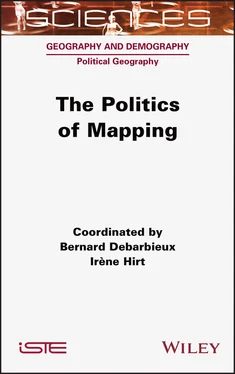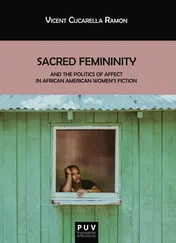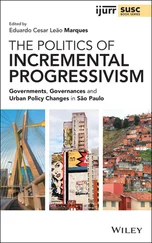1 ...7 8 9 11 12 13 ...17 Hirt, I. and Roche, S. (2013). Cartographie participative. In Dictionnaire critique et interdisciplinaire de la participation , Casillo, I., Barbier, R., Blondiaux, L., Chateauraynaud, F., Fourniau, J.-M., Lefebvre, R., Neveu, C., Salles, D. (eds). GIS Démocratie et Participation, Paris [Online]. Available at: http://www.dicopart.fr/fr/dico/cartographie-participative.
House, E.M. and Seymour, C. (eds) (1921). What Really Happened at Paris; The Story of the Peace Conference, 1918–1919 . C. Scribner’s Sons, New York [Online]. Available at: https://lccn.loc.gov/21008042.
Huffman, N. (1995). Silences and secrecy in the history of cartography: JB Harley, science and gender. In Proceedings of the 17th International Cartographic Conference . Institut Cartogràfic de Catalunya, Barcelona [Online]. Available at: https://icaci.org/files/documents/ICC_proceedings/ICC1995/.
Jacob, C. (2006). The Sovereign Map: Theoretical Approaches in Cartography throughout History . University of Chicago Press, Chicago [Original published in French 1992].
Kain, R.J.P. and Baigent, E. (1992). The Cadastral Map in the Service of the State: A History of Property Mapping . University of Chicago Press, Chicago.
Kitchin, R. and Dodge, M. (2007). Rethinking maps. Progress in Human Geography , 31(3), 331–344.
Kollektiv Orangotango (ed.) (2018). This is Not an Atlas: A Global Collection of Counter-Cartographies , 1st edition. Transcript Verlag, Bielefeld.
Kwan, M.-P. (2002a). Introduction: Feminist geography and GIS. Gender, Place & Culture , 9(3), 261–262.
Kwan, M.-P. (2002b). Is GIS for women? Reflections on the critical discourse in the 1990s. Gender, Place & Culture , 9(3), 271–279.
Lacoste, Y. (1976). La géographie, ça sert, d’abord, à faire la guerre . Éditions Maspero, Paris.
Lardon, S. and Noucher, M. (2016). Construire demain par les cartes : usages de l’information géographique en prospective territoriale participative. Cahiers de géographie du Québec , 60(170), 209.
Larousserie, D. (2013). Cartographie. La révolution numérique. Le Monde , 6 May 2013 [Online]. Available at: https://www.lemonde.fr/sciences/article/2013/05/06/cartographie-la-revolution-numerique_3171889_1650684.html.
Latour, B. (1987). Les “vues” de l’esprit. Réseaux , 5(27), 79–96.
Latour, B. (2005). La science en action : introduction à la sociologie des sciences . La Découverte, Paris [Original published in French 1987].
Lavado, J. (2018). Mafalda : intégrale . Glénat, Grenoble [Original published 1964].
MacEachren, A.M. (1995). How Maps Work: Representation, Visualization, and Design . Guilford Press, New York.
Marin, L. (1973). Utopiques : jeux d’espaces . Éditions de Minuit, Paris.
Marin, L. (1980). Les voies de la carte. In Cartes et figures de la Terre : exposition présentée au Centre Georges Pompidou du 24 mai au 17 novembre 1980 . Centre Georges Pompidou, Centre de création industrielle, Paris.
McLafferty, S.L. (2002). Mapping women’s worlds: Knowledge, power and the bounds of GIS. Gender, Place & Culture , 9(3), 263–269.
Mekdjian, S. and Amilhat Szary, A.-L. (2015). Cartographies traverses, des espaces où l’on ne finit jamais d’arriver. Visionscarto [Online]. Available at: https://visionscarto.net/cartographies-traverses.
Monmonier, M. (1991). How To Lie With Maps . The University of Chicago Press, Chicago.
Monteiro Sales, C. (2016). Cartografía, arte e visões de mundo na reproduçâo do “Mapa invertido da América do Sul”. Espaço e Cultura , 157–178.
Noucher, M. (ed.) (2013). Cartographies participatives. L’information géographique , 77(4).
Noucher, M. (2017). Les petites cartes du web. Approche critique des nouvelles fabriques cartographiques . Éditions Rue d’Ulm and Presses de l’École normale supérieure, Paris.
Noucher, M., Hirt, I., Arnauld de Sartre, X. (2019). Ordering the world through maps and figures. Critical approaches to metrology [Online]. Available at: https://www.espacestemps.net/en/articles/ordering-the-world-through-maps-and-figures/.
November, V., Camacho-Hübner, E., Latour, B. (2010). Entering a risky territory: Space in the age of digital navigation. Environment and Planning D: Society and Space , 28(4), 581–599.
Olsson, G. (2007). Abysmal: A Critique of Cartographic Reason . University of Chicago Press, Chicago.
Painter, J. (2008). Cartographic anxiety and the search for regionality. Environment and Planning A: Economy and Space , 40(2), 342–361.
Palsky, G. (2003). L’esprit des cartes : approches historiques, sémiologiques et sociologiques en cartographie. HDR Thesis, Université de Paris XII-Val-de-Marne, Paris.
Pavlovskaya, M. and St. Martin, K. (2007). Feminism and geographic information systems: From a missing object to a mapping subject: Feminism and geographic information systems. Geography Compass , 1(3), 583–606.
Peluso, N.L. (1995). Whose woods are these? Counter-mapping forest territories in Kalimantan, Indonesia. Antipode , 27(4), 383–406.
Pickles, J. (2004). A History of Spaces: Cartographic Reason, Mapping, and the Geo-coded World . Routledge, London, New York.
Putnam, H. (1984). Raison vérité et histoire (translated by A. Gerschenfeld) Éditions de Minuit, Paris.
Raffestin, C. (1979). Pour une géographie du pouvoir . Librairies techniques, Paris.
Raffestin, C. (1988). Le rôle de la carte dans une société moderne. Mensuration, photogrammétrie, génie rural , 4, 135–139.
Rambaldi, G. (2005). Who owns the map legend? URISA Journal , 17(1), 5–13.
Robinson, A.H. (1952). The Look of Maps: An Examination of Cartographic Design . University of Wisconsin Press, Madison.
Rommens, A. (2018). Latin American abstraction: Upending Joaquín Torres-García’s inverted map. Mosaic: An Interdisciplinary Critical Journal , 51(2), 35–58.
Rose-Redwood, R. (2015). Introduction: The limits to deconstructing the map. Cartographica: The International Journal for Geographic Information and Geovisualization , 50(1), 1–8.
Rundstrom, R. (1991). Mapping, postmodernism, indigenous people and the changing direction of North American cartography. Cartographica , 28(2), 1–12.
Schuurman, N. and Pratt, G. (2002). Care of the subject: Feminism and critiques of GIS. Gender, Place & Culture , 9(3), 291–299.
Scott, J.C. (1998). Seeing Like a State: How Certain Schemes to Improve the Human Condition Have Failed . Yale University Press, New Haven.
Smith, N. (1984). Political geographers of the past. Political Geography Quarterly , 3(1), 69–76.
Speier, H. (1941). Magic geography. Social Research , 8(3), 310–330.
Staszak, J.-F., Fall, J., Giraut, F. (2017). Les grands découpages du Monde. In Frontières en tous genres : cloisonnement spatial et constructions identitaires , Staszak, J.-F. (ed.). PUR, Rennes.
Topalov, C. (2004). Raconter ou compter ? L’enquête de Charles Booth sur l’East End de Londres (1886–1889). Mil neuf cent. Revue d’histoire intellectuelle , 22(1), 107–132.
Turnbull, D. (2000). Masons, Tricksters and Cartographers: Comparative Studies in the Sociology of Scientific and Indigenous Knowledge . Routledge, New York.
Valerio, V. (ed.) (2007). Cartografi veneti: mappe, uomini e istituzioni per l’immagine e il governo del territorio . Editoriale Programma, Padua.
Winichakul, T. (1994). Siam Mapped: A History of the Geo-body of a Nation . University of Hawaii Press, Honolulu.
Читать дальше












